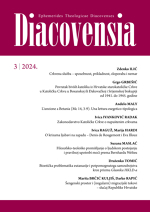Šengenski prostor i (iregularni) migracijski tokovi – slučaj Republike Hrvatske
Schengen Area and (Irregular) Migration Flows – the Case of the Republic of Croatia
Author(s): Marita Brčić Kuljiš, Darko RapićSubject(s): Migration Studies, Sociology of Politics, Asylum, Refugees, Migration as Policy-fields
Published by: Katolički bogoslovni fakultet u Đakovu
Keywords: European Union; Schengen; migrations; refugees; Republic of Croatia; securitization of migration;
Summary/Abstract: For the past ten years, the European continent has been struggling with an intense influx of migrants and refugees, especially in the period from 2015 to 2019, when this problem produced a kind of political and social crisis in Europe. Since 2019, migration flows have decreased due to the COVID-19 pandemic and the significant political reactions of the European Union as a whole and its members separately. On January 1, 2023, the Republic of Croatia entered the Schengen area, which gave its citizens the right to freely cross the internal borders of the member states of the Union without border checks. With this political decision, the European Union's border moved towards non-member states, and the Republic of Croatia became the country with the longest land border in the Union. In this paper, the authors deal with the subject of migration in relation to the expansion of the Schengen area, which, according to its idea and implementation, enables the movement of the population without border checks, and whether the entry of the Republic of Croatia into that area affected the intensity of migration flows towards and across Croatian border.
Journal: Diacovensia: teološki prilozi
- Issue Year: 32/2024
- Issue No: 3
- Page Range: 533-556
- Page Count: 24
- Language: Croatian

